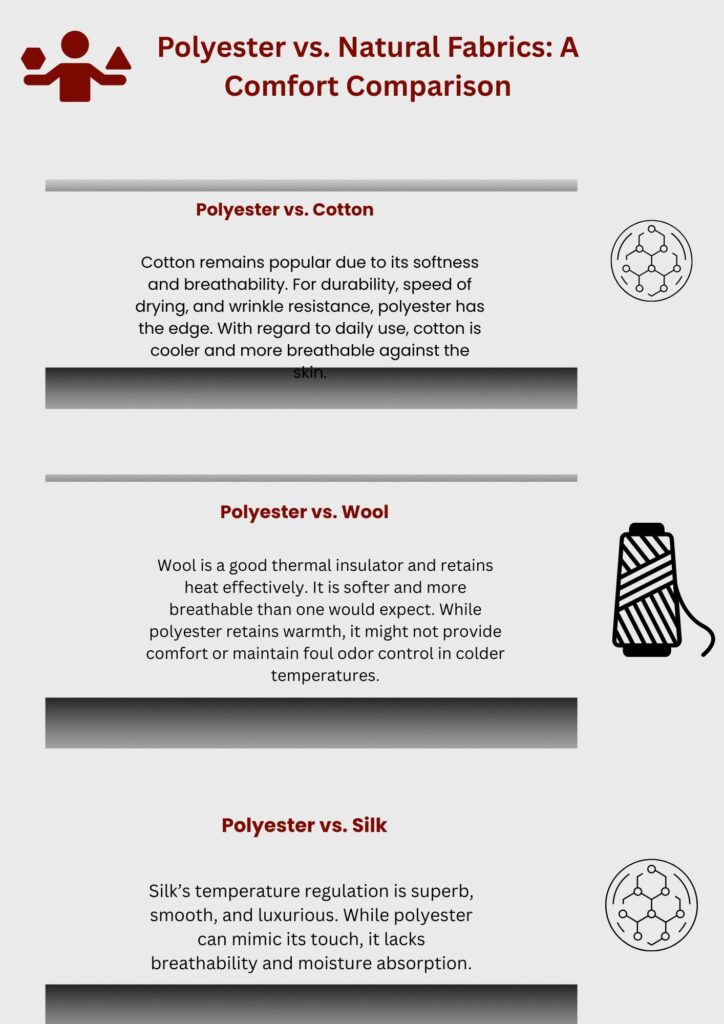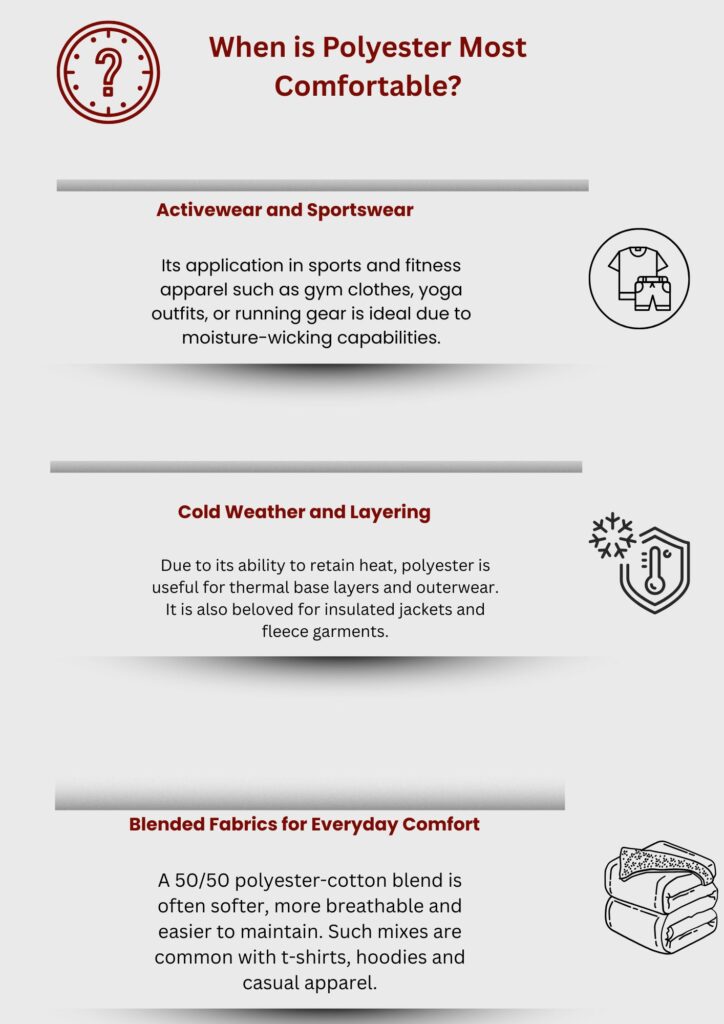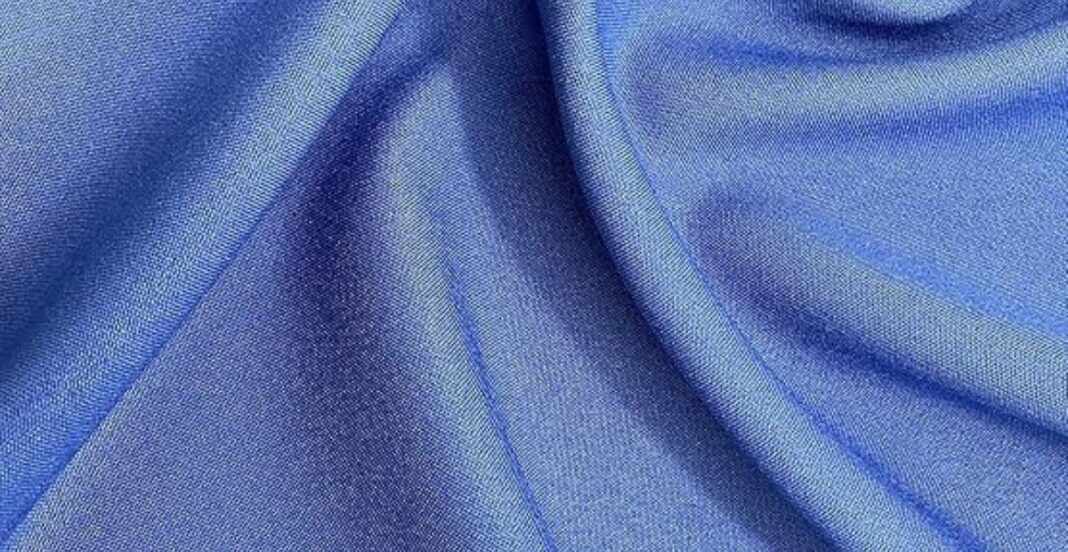Introduction
Polyester ranks among the most popular textiles globally. It is present in sports gear, comfortable sheets, and elegant dresses. However, a persistent issue arises: is polyester comfortable?
In bedsheets and sportswear, understanding comfort levels is crucial. While some people admire polyester for its softness and excellent durability, others complain about its irritating and overly synthetic feels. What criteria exactly determine its comfort?
Let’s analyze polyester, juxtapose it with natural fabrics, and determine when its comfort level is ideal or non-ideal.
What is Polyester?
Derived from petrochemicals, polyester is a synthetic fabric. It was first introduced in the early twentieth century, and gained widespread popularity in the 1970s because of its low cost and durability.
Polyester is a man made fabric whose strength, quick drying ability, and resistance to shrinking make it easy to care for. It is commonly used in sports and casual wear, as well as in upholstery and certain industrial applications. Blended with natural fibers, polyester improves the ease with which clothes can be put on and their appearance.
Today, technological advancements ensure that polyester fabrics are smoother to touch and even softer than before, allowing them to imitate silk and cotton. However, does such improvement guarantee that they provide comfort?
Is Polyester Comfortable? Understanding the Key Factors
Let’s tackle the question directly: Is polyester comfortable? As with many fabrics, comfort in polyester is dependent on a few critical factors. Here’s an overview of what determines comfort:
Breathability: Does Polyester Trap Heat?
Polyester does not breathe as easily as cotton or linen; it is considerably warmer and can retain heat. This decreases airflow which results in being overheated. Contrarily, cotton has a greater airflow and is likely to be cooler.
Nevertheless, modern polyester micro perforation and mesh technologies improve fabric breathability, especially in sportswear. Such fabrics have good airflow and, therefore, improve comfort.
Moisture-Wicking: Does It Manage Sweat?
Polyester’s most impressive trait is its moisture-wicking properties. It pulls sweat away from the body and facilitates evaporation, making it useful for physical activities.
Many athletes and runners prefer polyester performance wear because, unlike cotton which absorbs moisture and clings to the skin, polyester will remain relatively dry.
Softness: How Does Polyester Feel on Skin?
How carefully polyester is manufactured determines its softness. Smooth, light, and soft to the touch polyester blends differ greatly from rough and itchy lower-grade polyester performance wear.
Natural fibers such as cotton or silk can be simulated when the fibers are brushed or treated. Your skin’s perception of the fabric is also influenced by its finishing processes and fiber diameter.
Temperature Regulation: Is It Comfortable Year-Round?
Polyster helps in maintaining thermal insulation during cold weather. The heat retention capability of polyester makes it ideal for winter garments and as a base layer. Its heat-trapping properties, however, may lead to excessive perspiration during summer.
Unless specifically designed for breathability, polyester is not ideal for hot climates.
Static & Pilling: Does It Cause Skin Discomfort?
During dry conditions, it is susceptible to building static electricity which can lead to static cling. This is deemed annoying by some individuals.
It leads to an increase in pilling, the small balls of fiber that accumulate due to consistent wearing or washing of an item. Pilling results in a rough feel in conjunction with a bumpy appearance, particularly in lower quality clothes.
Pros of Polyester for Comfort
Notwithstanding some apprehensions, polyester provides numerous comfort-related benefits when manufactured and utilized correctly:
Lightweight and Wrinkle-Resistant
Polyester is relatively lightweight when compared to cotton or linen, making it easier to wear during activities for longer periods. Additionally, polyester’s low tendency to wrinkle adds to practical comfort.
This feature coupled with other features of polyester makes it particularly useful for people who travel frequently or lead a busy lifestyle, where easy to maintain clothing is a major advantage.
Quick-Drying and Moisture-Wicking
As with all synthetic fabrics, polyester has the advantage of drying very quickly. It does not absorb water like natural fibers do. This is beneficial for sportswear as well as for areas with frequent rains.
This property is also appreciated during workouts and hikes.
Works Well in Fabric Blends
The blends are even better. 50% cotton and 50% polyester for example contains cotton which makes it softer and more breathable, while keeping the strength of synthetic fibers.
Blending pure polyester with cotton or other materials also reduces pilling, static electricity, and that plasticky feel associated with polyester.
Cons of Polyester for Comfort
Despite all the advantages of polyester for practical applications, its ease of use generates some comfort-related issues:
Feels “Plastic-Like” or Itchy in Some Forms
Volatile synthetic fibers can feel harsh to the touch and overly shiny or plastic-like. This causes discomfort when worn against the skin and can, in some instances, provoke irritation to sensitive skin.
Discomfort arising from synthetic fibers is often due to the quality of the fabric rather than the fiber itself.
Poor Breathability in Hot Climates
Because polyester breathability is not up to standards when compared to cotton, it becomes less ideal for hot or tropical environments. It is capable of trapping heat and sweat leading to odor issues.
If properly ventilated, garments made out of polyester can be used as summer clothing however that is a very narrow subset of clothing.
Prone to Static and Odors
Due to polyester’s static nature, it is more susceptible to static cling. Odors can be retained as well as a result of polyester’s inability to soak in moisture like natural fibers. Without the right cleaning, these odors will accumulate.
Polyester vs. Natural Fabrics: A Comfort Comparison
Examining comfort-centric natural fibers alongside polyester, we note the following:

Polyester vs. Cotton
Cotton remains popular due to its softness and breathability. For durability, speed of drying, and wrinkle resistance, polyester has the edge. With regard to daily use, cotton is cooler and more breathable against the skin.
It is possible to achieve a blend of both fabrics where the end product is soft and does not lose strength.
Polyester vs. Wool
Wool is a good thermal insulator and retains heat effectively. It is softer and more breathable than one would expect. While polyester retains warmth, it might not provide comfort or maintain foul odor control in colder temperatures.
Wool also adapts to temperature changes better than polyester, which can lead to overheating.
Polyester vs. Silk
Silk’s temperature regulation is superb, smooth, and luxurious. While polyester can mimic its touch, it lacks breathability and moisture absorption.
Still, poly-silk blends offer decent comfort, yet remain more budget friendly and low maintenance.
When is Polyester Most Comfortable?
There are particular instances wherein comfort is derived from polyester:

Activewear and Sportswear
Its application in sports and fitness apparel such as gym clothes, yoga outfits, or running gear is ideal due to moisture-wicking capabilities.
It is preferred by most athletes over cotton during workouts and long distance activities.
Cold Weather and Layering
Due to its ability to retain heat, polyester is useful for thermal base layers and outerwear. It is also beloved for insulated jackets and fleece garments.
Polyester maintains warmth without adding extra bulk when layered correctly.
Blended Fabrics for Everyday Comfort
A 50/50 polyester-cotton blend is often softer, more breathable and easier to maintain. Such mixes are common with t-shirts, hoodies and casual apparel.
The blend reduces the “synthetic” feeling, adds breathability, and greatly enhances comfort.
Tips to Make Polyester More Comfortable
If you want to enhance the comfort of wearing polyester garments, consider the following recommendations:
Choose High-Quality Polyester
Not all polyesters are equal. Softer and smoother polyester fabrics can be found in finely woven or brushed polyester varieties.
Comfort is also enhanced by higher thread counts as well as well-executed finishing.
Look for Moisture-Wicking Features
Purchase polyester apparel marked “moisture-wicking” or “climate control.” These features are designed to maintain dryness and cooling.
In activewear and summer apparel, their effectiveness is maximized.
Use Fabric Softener
Soaking your polyester clothes in fabric softener helps to soften the material and decreases static cling. Over time, a smoother texture is felt.
This approach requires no substantial changes to one’s closet but greatly enhances comfort.
Wear Polyester in Blends
Selecting blended fabrics, such as poly-cotton or poly-rayon, enhances comfort considerably. These fabrics integrate the strength of polyester with the gentleness of natural fibers.
They are also more appropriate for sensitive skin and regular use.
Common Myths About Polyester Comfort
Let’s alleviate some misconceptions on polyester and comfort:
“Polyester is Always Uncomfortable”
That is incorrect. A high-quality polyester can resemble cotton in softness and breathability. In fact, engineered polyester is used by high-end brands because it provides a luxurious feel.
While 100% polyester can be irritating for some people, blended forms are usually safe and comfortable for those with sensitive skin.
“It’s Bad for Sensitive Skin”
Remember to look for labels stating hypoallergenic or skin-protective finishes.
User Reviews and Real-World Experiences
A wide range of users have commented on the comfort of polyester in these specific areas:
- Athletes appreciated polyester for its lightweight nature and the ease in which it ventilated sweat during exercise.
- Casual users appreciated soft poly-cotton blends for t-shirts and sleepwear.
- Fashion shoppers particularly like wearing flowy and wrinkle-free polyester dresses during the colder months.
Surveys indicate that 7 out 10 people consider polyester comfortable when blended or used appropriately.
Conclusion
Comfortable polyester—does it exist? Yes, but only when it’s blended correctly, used for the right purpose, and is of high quality.
That said, high-quality polyester is perfect for travel and active wear, as well as for layering in cold weather. Cold climates may feel uncomfortably stuffy, especially when featuring 100% polyester fabrics.
Final recommendation: It is best to use polyester moisture-wicking or moisture-wicking blends for optimal comfort experience. Keep in mind your activity, environment, and skin type when deciding if polyester is suitable for you.
FAQs
Yes, polyester can be comfortable for everyday wear, especially when blended with natural fibers like cotton. It’s lightweight, wrinkle-resistant, and soft in higher-quality forms. However, 100% polyester may feel less breathable in hot climates.
Polyester doesn’t breathe as well as cotton, so it may trap heat and cause sweating in warm conditions. However, moisture-wicking polyester is designed to draw sweat away from the body, making it suitable for workouts and activewear.
Some people with sensitive skin may experience irritation from low-quality polyester. However, high-quality or blended polyester (e.g., poly-cotton) is generally safe and feels smoother on the skin.


